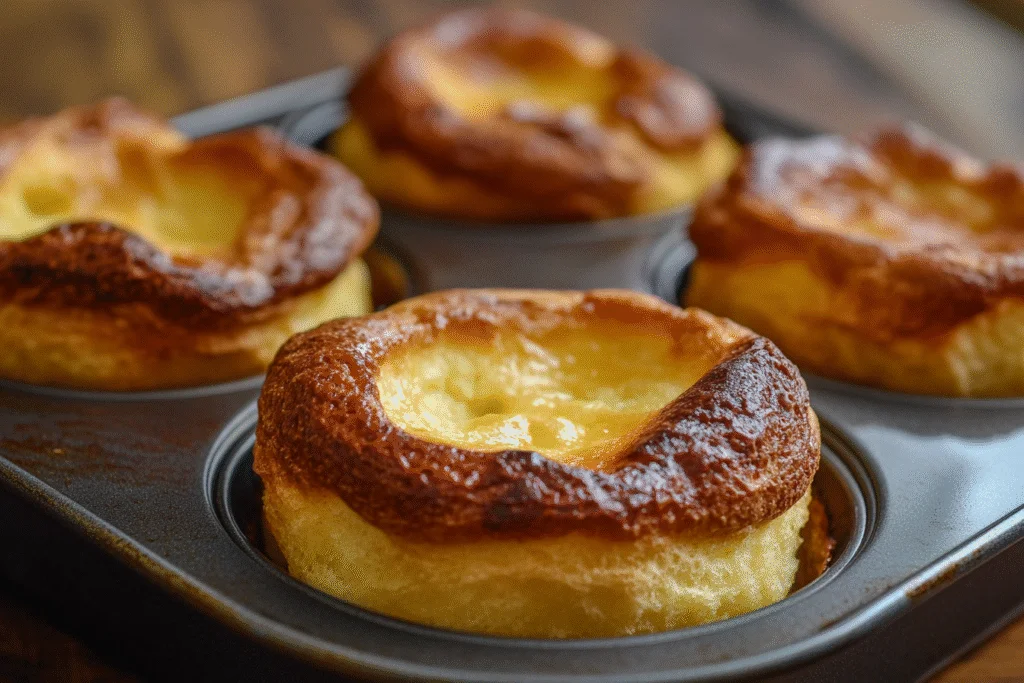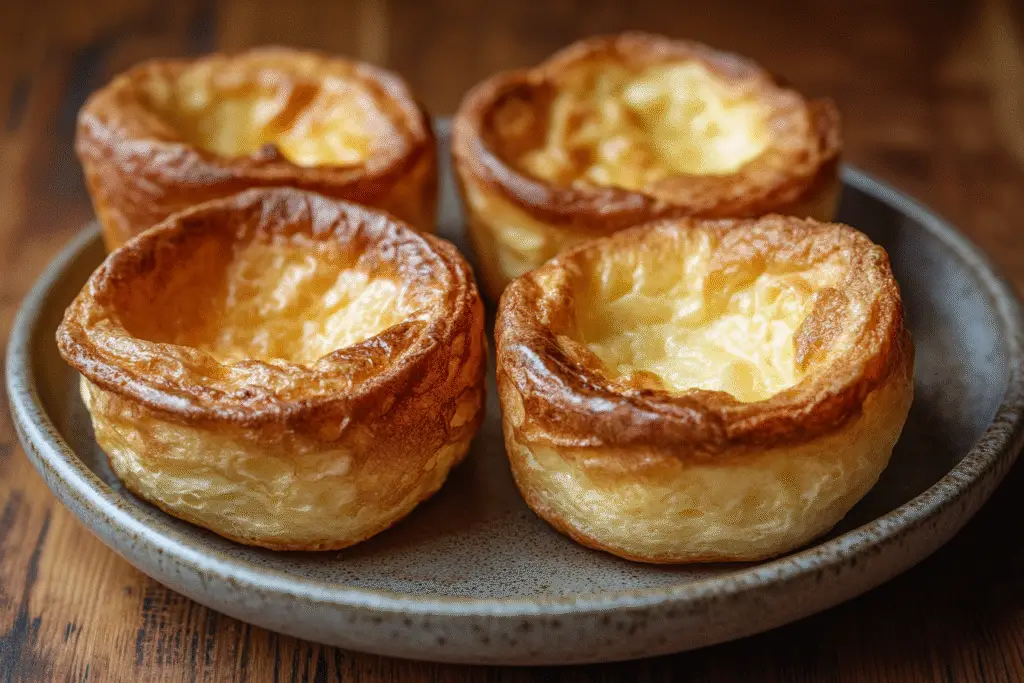Few things are as satisfying as the dramatic rise and golden crisp of a perfectly baked Yorkshire pudding. These iconic British staples are the crown jewel of a Sunday roast—light and airy on the inside, deeply browned and crisp on the outside, and perfect for soaking up rich gravy. While they may look complex, Yorkshire puddings are delightfully simple when you understand the key techniques that make them rise sky-high every time.
In this comprehensive recipe, we’ll guide you through the entire process—from selecting the right pan and ingredients to troubleshooting common pitfalls. Whether you’re new to making them or looking to refine your approach, this recipe ensures you’ll end up with puddings that puff beautifully and deliver on both flavor and texture.
What Are Yorkshire Puddings?
Yorkshire puddings are traditional British pastries made from a simple batter of eggs, flour, and milk. They’re closely related to popovers in American baking and were originally served as a filler before the meat course to stretch meals economically.
Baked in very hot oil, the batter puffs dramatically in the oven, forming a crisp, hollow shell with a soft, custardy base. Traditionally served with roast beef and gravy, they’re now a beloved part of roast dinners across the UK—and gaining popularity worldwide.

Why This Recipe Works
Achieving tall, crisp Yorkshire puddings depends on three things:
- Hot fat: The oil must be smoking hot when the batter is poured in. This creates instant steam and rapid rise.
- Room-temperature batter: Allows for faster cooking and better puff.
- High oven heat and no peeking: A hot oven creates the burst of steam needed for lift, and opening the door too early deflates the puddings.
This recipe also uses a slightly higher egg-to-flour ratio for a richer, more stable rise and deeper flavor.
Ingredients You’ll Need
The classic Yorkshire pudding batter requires just three main ingredients, but quality and proportions matter:
- Eggs: Provide structure and lift. Use large, room-temperature eggs.
- Milk: Whole milk gives the best texture and flavor.
- Flour: All-purpose (plain) flour keeps things light and crisp.
- Salt: Just enough to balance and enhance the flavor.
- Oil or beef drippings: Essential for flavor and creating the hot base needed for the rise.
Optional: A little butter or ghee mixed with the oil can boost flavor, especially if not using beef drippings.

Recommended Equipment
- Muffin tin or Yorkshire pudding tray with deep wells
- Measuring jug or bowl with spout
- Mixing bowl and whisk
- Ladle or measuring cup
- Oven mitts (you’ll be handling a hot pan)
For classic individual puddings, a 12-cup muffin tin is ideal. You can also use a large roasting pan for one big pudding to slice and serve.
Ingredients
- 4 large eggs
- 1 cup (240ml) whole milk
- 1 cup (120g) all-purpose flour
- ½ teaspoon kosher salt
- 1–2 teaspoons beef drippings, vegetable oil, or sunflower oil per pudding cup (about ¼ cup total)
Step-by-Step Instructions
Step 1: Make the Batter
Crack the eggs into a mixing bowl and whisk well.
Add the milk and salt, whisk again, then gradually add the flour, whisking until the batter is smooth. A few small lumps are okay, but it should be pourable and consistent.
Let the batter rest for at least 30 minutes at room temperature (or up to 2 hours). You can also refrigerate it overnight—just bring it to room temp before baking.
Step 2: Preheat the Oven and Pan
Preheat your oven to 450°F (230°C). Place the muffin tin on a middle rack and add 1–2 teaspoons of oil or drippings into each cup.
Heat the empty pan with oil in the oven for at least 10 minutes, or until the oil is shimmering and just starting to smoke. This step is crucial.
Step 3: Fill and Bake
Carefully remove the hot tin from the oven using oven mitts. Quickly pour the batter into each cup, filling about halfway. You should hear a sizzle—that’s a good sign.
Work swiftly but safely, and return the tin to the oven as soon as possible.
Bake for 20–25 minutes without opening the oven door. The puddings should puff up dramatically and turn golden brown.
If using a large pan for a single pudding, increase bake time to 30–35 minutes.
Step 4: Serve Immediately
Yorkshire puddings are best served hot and fresh out of the oven.
Use tongs or a spoon to lift them from the pan. If they stick slightly, run a knife around the edges.
Serve with a roast dinner, plenty of gravy, and your favorite sides.
Flavor Variations and Add-Ins
While traditional Yorkshire puddings are plain, you can customize them subtly:
- Herbs: Add a pinch of chopped rosemary, thyme, or chives to the batter.
- Cheese: Sprinkle a little grated sharp cheddar into the cups before pouring in the batter.
- Black pepper or mustard powder: Stir into the batter for a savory kick.
These variations work best when served with beef, lamb, or hearty vegetarian roasts.
Common Mistakes (and Fixes)
- Flat puddings? Oil wasn’t hot enough or oven door was opened during baking.
- Too dense? Batter may have been overmixed or too cold when baked.
- Greasy bottoms? Use less oil next time, or allow puddings to drain briefly after baking.
- Not puffing evenly? Check that your oven is fully preheated and your pan is level.
Make-Ahead Tips and Reheating
Yorkshire puddings are best fresh, but you can still make them ahead:
To Make Ahead:
- Bake fully, then cool completely.
- Store in an airtight container in the fridge for up to 2 days.
To Reheat:
- Preheat oven to 400°F (200°C).
- Place puddings directly on the oven rack and bake for 5–8 minutes, until crisp and hot.
To Freeze:
- Let cool, then freeze in a single layer on a tray.
- Transfer to a freezer bag and store for up to 1 month.
- Reheat from frozen at 425°F for 10–12 minutes.
What to Serve With Yorkshire Puddings
Traditionally part of a Sunday roast, Yorkshire puddings are best with:
- Roast beef with onion or red wine gravy
- Roasted lamb or pork
- Mashed or roasted potatoes
- Steamed greens or glazed carrots
- Horseradish sauce or mustard
You can also serve them with sausages and gravy as Toad in the Hole, or go sweet with jam and whipped cream.
Yorkshire Pudding vs. Popovers
They’re essentially the same batter, but:
- Yorkshire puddings use beef drippings and are served with savory roasts.
- Popovers are often baked in taller tins and served as a bread or sweet treat.
The method and result are nearly identical, though Yorkshire puddings often have a slightly richer flavor from the drippings.
With their golden crisp shell and soft, eggy interior, these Yorkshire puddings are the ultimate companion to a roast dinner. Mastering them is simpler than it looks—and once you do, you’ll want them on the table every weekend. Light, airy, and deeply satisfying, they’re a true classic for good reason.
